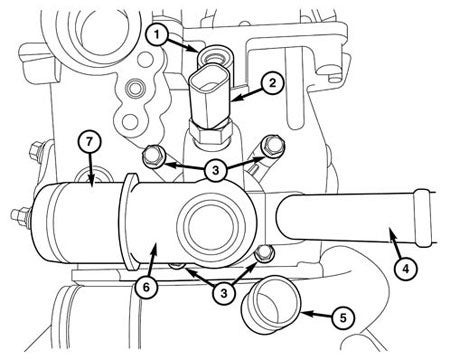The P0128 code is a common trouble code in modern vehicles, indicating a problem with your car’s thermostat. As a crucial component of the engine’s cooling system, the thermostat plays a vital role in maintaining optimal engine temperature. When your car’s computer detects that the coolant temperature is below the thermostat’s regulating temperature, it triggers the P0128 code. This article will guide you through understanding the P0128 code, its symptoms, and how to address it, potentially even with a DIY thermostat replacement.
Decoding the P0128 Code: Coolant Thermostat Malfunction
The P0128 code, as indicated by your OBD-II scanner, essentially means “Coolant Thermostat (Coolant Temperature Below Thermostat Regulating Temperature)”. This signifies that your engine coolant is not reaching the expected operating temperature within a reasonable timeframe after starting the engine. This issue often points to a malfunctioning thermostat that is stuck open, preventing the engine from warming up properly.
Symptoms of a P0128 Code:
Recognizing the symptoms associated with a P0128 code is crucial for timely diagnosis and repair:
- Check Engine Light: The most immediate sign is the illumination of your car’s check engine light.
- Decreased Fuel Efficiency: A consistently cooler engine can lead to inefficient fuel combustion, reducing your car’s miles per gallon.
- Engine Running Cooler Than Usual: Your temperature gauge might consistently read lower than normal, especially in cold weather.
- Slow Cabin Heat Warm-up: You might notice that it takes longer than usual for your car’s heater to produce warm air.
- Engine Performance Issues: In some cases, a prolonged cool engine temperature can affect engine performance.
Causes Behind the P0128 Error Code:
While the P0128 code directly points to the thermostat, several factors can contribute to this issue:
- Stuck Open Thermostat: This is the most common cause. A thermostat stuck in the open position allows coolant to continuously circulate to the radiator, overcooling the engine.
- Faulty Coolant Temperature Sensor: Although less frequent, a malfunctioning coolant temperature sensor can provide incorrect readings to the engine computer, triggering the P0128 code even if the thermostat is working correctly.
- Cooling System Issues: In rare instances, problems within the cooling system, such as a faulty radiator fan running continuously, could contribute to the engine not reaching optimal temperature.
- Wiring or Connector Problems: Damaged wiring or loose connectors related to the coolant temperature sensor can also cause inaccurate readings and trigger the code.
Diagnosing and Resolving the P0128 Code
When faced with a P0128 code, a systematic approach to diagnosis is essential.
- OBD-II Scanner Verification: Use an OBD-II scanner to confirm the presence of the P0128 code and check for any other related codes. This helps ensure accurate diagnosis.
- Visual Inspection: Inspect the thermostat housing area for any visible leaks or damage. Check the wiring and connectors leading to the coolant temperature sensor for corrosion or loose connections.
- Coolant Temperature Sensor Test: A multimeter can be used to test the coolant temperature sensor’s resistance. Compare the readings to the manufacturer’s specifications to determine if the sensor is faulty.
- Thermostat Function Test: In some cases, a visual inspection of the thermostat (after removal) can reveal if it’s stuck open. However, a more reliable method is to test it in a pot of hot water to see if it opens and closes at the correct temperature.
DIY Thermostat Replacement: A Step-by-Step Guide
For those comfortable with DIY car repairs, replacing the thermostat can often be done at home, potentially saving on labor costs. The following steps provide a general guide, but always refer to your vehicle’s specific repair manual for detailed instructions and safety precautions.
Tools You’ll Need:
- New Thermostat and gasket/O-ring
- Socket set and wrenches
- Pliers
- Drain pan
- Coolant
- OBD-II Scanner (to clear the code)
- Optional: UView Airlift or similar coolant refill tool
Safety First:
- Caution: Never work on a hot engine. Allow your engine to cool down completely before starting any work to avoid burns from hot coolant or engine parts.
- Caution: Coolant can be harmful and should be disposed of properly.
Step-by-Step Thermostat Replacement:
-
Disconnect the Battery: Begin by disconnecting the negative battery cable to prevent electrical shorts during the repair process. If your vehicle has an Intelligent Battery Sensor (IBS), disconnect the IBS connector first.
-
Remove Engine Cover and Battery Components: Remove the engine cover to access the thermostat housing. You may need to remove the battery and battery tray assembly to gain better access, as shown in the original guide for certain models. Refer to your vehicle’s service manual for battery and battery tray removal procedures if needed.
-
Drain Coolant: Locate the radiator drain plug (usually at the bottom of the radiator) and place a drain pan underneath. Carefully open the drain plug to drain the coolant. Caution: Do not attempt to drain coolant from a hot system.
-
Access Thermostat Housing: Depending on your vehicle model, you may need to remove other components to access the thermostat housing. In the original guide, steps include removing the belly pan, brake vacuum pump, and positioning the PDC (Power Distribution Center) to the side. These steps might vary based on your car’s make and model.
-
Disconnect Hoses and Sensor: Carefully disconnect the coolant hoses connected to the thermostat housing. You may need to use pliers to loosen hose clamps. Disconnect the engine coolant temperature sensor harness connector.
 Coolant hose and sensor connections to thermostat housing
Coolant hose and sensor connections to thermostat housing -
Remove Thermostat Housing: Remove the bolts securing the thermostat housing to the engine. Carefully detach the housing and remove the old thermostat.
Image illustrating the thermostat housing and its components.
-
Install New Thermostat and Housing: Clean the mating surfaces of the thermostat housing and engine block. Install the new thermostat with a new gasket or O-ring in the correct orientation. Reinstall the thermostat housing and tighten the bolts to the manufacturer’s specified torque.
-
Reconnect Hoses and Sensor: Reconnect all coolant hoses to the thermostat housing and secure them with clamps. Reconnect the engine coolant temperature sensor harness connector.
-
Reinstall Removed Components: Reinstall any components that were removed for access, such as the battery tray, battery, engine cover, brake vacuum pump, and belly pan, in reverse order of removal.
-
Refill Coolant: Refill the cooling system with the correct type and amount of coolant as specified in your vehicle’s owner’s manual. Using a UView Airlift or similar tool can help prevent air pockets in the system.
-
Bleed the Cooling System: If you don’t use a vacuum refill tool, you’ll need to bleed the cooling system to remove any trapped air. This usually involves running the engine with the radiator cap off (while monitoring temperature) and topping off coolant as needed. Refer to your vehicle’s service manual for the specific bleeding procedure.
-
Check for Leaks and Test Drive: Start the engine and check for any coolant leaks around the thermostat housing and hose connections. Monitor the engine temperature gauge to ensure it reaches and maintains the normal operating temperature. Take your vehicle for a test drive to verify the repair and ensure the P0128 code does not return.
-
Clear the P0128 Code: Use your OBD-II scanner to clear the P0128 code from the vehicle’s computer memory.
Vacuum Pump Note (Based on Original Article Snippet)
The original article includes a section on vacuum pump removal, which might be necessary for accessing the thermostat housing on some vehicle models. If your vehicle requires vacuum pump removal, follow these general steps, referring to your service manual for specific details:
-
Disconnect Vacuum Line: Disconnect the vacuum line from the pump by carefully pressing the fitting retainer and pulling the line off.
Image showing vacuum pump line disconnection point.
-
Remove Vacuum Pump Bolts: Remove the bolts securing the vacuum pump to the engine.
Image illustrating vacuum pump mounting bolts.
-
Remove Vacuum Pump: Carefully remove the vacuum pump, noting the location of any gaskets or seals.
-
Reinstallation: When reinstalling the vacuum pump, use a new gasket and ensure it is properly aligned.
Conclusion: Resolving the P0128 Code and Thermostat Issues
The P0128 code indicates a coolant thermostat malfunction, often due to a thermostat stuck open. Understanding the symptoms, causes, and diagnostic steps is crucial for addressing this issue effectively. While DIY thermostat replacement is possible for many car owners, always prioritize safety and consult your vehicle’s repair manual for specific instructions. If you are not comfortable performing the repair yourself, it’s best to seek assistance from a qualified mechanic to ensure proper diagnosis and repair of the P0128 code and your vehicle’s cooling system. Addressing a P0128 code promptly will help maintain your engine’s health, fuel efficiency, and overall vehicle performance.

